Chairman of the Workers' Party of Korea
| Chairman of the Workers' Party of Korea 조선로동당 위원장 | |
|---|---|
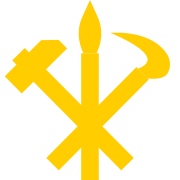 Logo of the Workers' Party of Korea | |
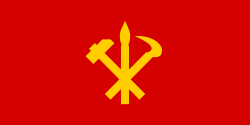 Flag of the Workers' Party of Korea | |
| Workers' Party of Korea | |
| Type | Party leader |
| Nominator | WPK Congress |
| Appointer | WPK Congress |
| Term length | No fixed term |
| Constituting instrument | WPK Charter |
| Inaugural holder | Kim Tu-bong |
| Formation | 28 August 1946 |
| Deputy | Vice Chairman |
| Chairman of the Workers' Party of Korea | |
| Chosŏn'gŭl | 조선로동당 위원장 |
|---|---|
| Hancha | 朝鮮勞動黨 委員長 |
| Revised Romanization | Joseon Rodongdang Wiwonjang |
| McCune–Reischauer | Chosŏn Rodongdang Wiwonjang |
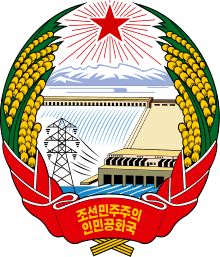 |
|---|
| This article is part of a series on the politics and government of North Korea |
|
|
|
Related topics |
The Chairman of the Workers' Party of Korea (WPK) is the head of the Workers' Party of Korea, the ruling party of North Korea. The Chairman also serves as head of the Central Military Commission of North Korea and Chairman of the State Affairs Commission. Since the WPK's formation in 1946, the leader's post has been titled as Chairman (1946–1966), General Secretary (1966–2011, vacant from 1994–1997), First Secretary (2011–2016), and Chairman again since 2016.
The office of Chairman of the Central Committee was established at the 1st Congress (held in August 1946), and elected Kim Tu-bong (who was not a member of the Kim family) to the office.[1] After the WPNK merged with its southern counterpart in 1949, Premier Kim Il-sung, who had held the real power since independence, became chairman of the merged party.
The post was replaced at the October 1966 2nd Conference by the General Secretary of the Central Committee; through this office, Kim Il-sung became the formal head of the party's Secretariat.[2] After Kim Il-sung's death in 1994, the post was vacant for three years.[3] On 8 October 1997, Kim Jong-il was appointed to the new office of General Secretary of the Workers' Party of Korea in a joint announcement by the Central Committee (CC) and the Central Military Commission (CMC) of the Workers' Party of Korea: "[The CC and the CMC] pronounce comrade Kim Jong-il as general secretary of the party, based upon the wishes of the entire People's Army, people, and the members of the party."[3] At the 3rd Conference, the party charter was amended to require the general secretary to concurrently chair the Central Military Commission.[4] When Kim Jong-il died the WPK left the post of General Secretary vacant at the 4th Conference, making him "Eternal General Secretary".[5] Kim Jong-un was elected to the office of First Secretary of the Workers' Party of Korea,[5] which was established to "represent and lead the whole party as its head and materialize the ideas and lines of Kim Il-sung and Kim Jong-il."[6] At the 7th WPK Congress the office of First Secretary of the Workers' Party of Korea was abolished, and replaced by the office of Chairman of the Workers' Party of Korea.[7]
The WPK Chairman alongside his vice chairmen make up the WPK Executive Policy Bureau.[7] The office of Vice Chairman and the organ of the Executive Policy Bureau was established at the 7th WPK Congress in 2017.[7] Currently there are 9 vice chairmen; Choe Ryong-hae, Kim Ki-nam, Choe Thae-bok, Ri Su-yong, Kim Phyong-hae, O Su-yong, Kwak Pom-gi, Kim Yong-chol and Ri Man-gon.[8] The Executive Policy Bureau replaced the Secretariat, but its still unknown how and if these two organs have an institutionally different roles from one another.[7]
Leader offices
Note CC is an abbreviation for Central Committee of the Workers' Party of Korea and CMC an abbreviation for the Central Military Commission of the Workers' Party of Korea.
| Title | Existence | Established |
|---|---|---|
| Chairman of the Central Committee of the Workers' Party of Korea | 1946–1966 | 1st Congress |
| General Secretary of the Central Committee of the Workers' Party of Korea | 1966–1997 | 2nd Congress |
| General Secretary of the Workers' Party of Korea | 1997–2012 | Joint CC–CMC Communique |
| First Secretary of the Workers' Party of Korea | 2012–2016 | 4th Congress |
| Chairman of the Workers' Party of Korea | 2016–present | 7th Congress |
Office holders
| Chairman of the Central Committee of the Workers' Party of North Korea 북조선로동당 중앙위원회 위원장 | ||||
|---|---|---|---|---|
| Chairman | Term | Election | ||
 |
Kim Tu-bong 김두봉 1889–1958 |
31 August 1946 | 30 March 1948 | 1st Central Committee |
| 30 March 1948 | 30 June 1949 | 2nd Central Committee | ||
| Chairman of the Central Committee of the Workers' Party of Korea 조선로동당 중앙위원회 위원장 | ||||
| Chairman | Term | Election | ||
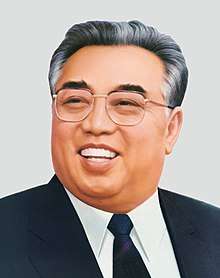 |
Kim Il-sung 김일성 1912–1994 |
30 June 1949 | 29 April 1956 | 2nd Central Committee |
| 29 April 1956 | 18 September 1961 | 3rd Central Committee | ||
| 18 September 1961 | 12 October 1966 | 4th Central Committee | ||
| General Secretary of the Central Committee of the Workers' Party of Korea 조선로동당 중앙위원회 총비서 | ||||
| General Secretary | Term | Election | ||
 |
Kim Il-sung 김일성 1912–1994 |
12 October 1966 | 13 November 1970 | 4th Central Committee |
| 13 November 1970 | 14 October 1980 | 5th Central Committee | ||
| 14 October 1980 | 8 July 1994 | 6th Central Committee | ||
| Vacant (8 July 1994–8 October 1997) | ||||
| General Secretary of the Workers' Party of Korea 조선로동당 총비서 | ||||
| General Secretary | Term | Election | ||
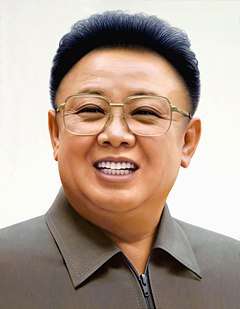 |
Kim Jong-il 김정일 1941–2011 |
8 October 1997 | 28 September 2010 | 6th Central Committee |
| 28 September 2010 | 17 December 2011 | |||
| Vacant (17 December 2011–11 April 2012) | ||||
| First Secretary of the Workers' Party of Korea 조선로동당 제1비서 | ||||
| First Secretary | Term | Election | ||
_(cropped).jpg) |
Kim Jong-un 김정은 born 1983 |
11 April 2012 | 9 May 2016 | 6th Central Committee |
| Chairman of the Workers' Party of Korea 조선로동당 위원장 | ||||
| Chairman | Term | Election | ||
_(cropped).jpg) |
Kim Jong-un 김정은 born 1983 |
9 May 2016 | Present | 7th Central Committee |
Eternal General Secretary
| Name (birth–death) |
Portrait | Designated |
|---|---|---|
| Kim Jong-il (1941–2011) |
 |
11 April 2012 |
References
Footnotes
- ↑ Lankov 2002, p. 31.
- ↑ Buzo 1999, p. 34.
- 1 2 Yŏnʼguso 1997, p. 668.
- ↑ "4th Party Conference To Convene in "mid-April"". North Korea Leadership Watch. 2 February 2012. Retrieved 12 March 2013.
- 1 2 Gause 2013, pp. 40–41.
- ↑ Frank 2013, p. 45.
- 1 2 3 4 Madden, Michael (20 May 2016). "Deciphering the 7th Party Congress: A Teaser for Greater Change?". 38North. Retrieved 29 April 2018.
- ↑ "The Party". North Korean Leadership Watch. Retrieved 29 April 2018.
Bibliography
Articles, books and journal entries
- Haggard, Stephen; Herman, Luke; Ryu, Jaesung (July–August 2014). "Political Change in North Korea: Mapping the Succession". Asian Survey. University of California Press. 54 (4): 773–780. doi:10.1525/as.2014.54.4.773. JSTOR 10.1525/as.2014.54.4.773.
- Kim, Nam-Sik (Spring–Summer 1982). "North Korea's Power Structure and Foreign Relations: an Analysis of the Sixth Congress of the KWP". The Journal of East Asian Affairs. Institute for National Security Strategy. 2 (1): 125–151. JSTOR 23253510.
- Staff writer (2012 & 2014). Understanding North Korea. Ministry of Unification. Check date values in:
|year=(help)
Books
- Buzo, Adrian (1999). The Guerilla Dynasty: Politics and Leadership in North Korea. I.B. Tauris. ISBN 1860644147.
- Frank, Rüdiger (2013). "North Korea in 2012: Domestic Politics, the Economy and Social Issues". Korea 2013: Politics, Economy and Society. BRILL Publishers. ISBN 9004262970.
- Gause, Ken E. (2011). North Korea Under Kim Chong-il: Power, Politics, and Prospects for Change. ABC-CLIO. ISBN 0313381755.
- — (2013). "The Role and Influence of the Party Apparatus". In Park, Kyung-ae; Snyder, Scott. North Korea in Transition: Politics, Economy, and Society. Rowman & Littlefield. pp. 19–46. ISBN 1442218126.
- Kim, Samuel (2000). "North Korean Informal Politics". Informal Politics in East Asia. Cambridge University Press. ISBN 0521645387.
- Lankov, Andrei (2002). From Stalin to Kim Il Song: The Formation of North Korea, 1945–1960. C. Hurst & Co. Publishers. ISBN 1850655634.
- Lankov, Andrei (2007). Crisis in North Korea: The Failure of De-Stalinization, 1956. University of Hawaii Press. ISBN 0824832078.
- Suh, Dae-sook (1988). Kim Il Sung: The North Korean Leader (1st ed.). Columbia University Press. ISBN 0231065736.
- Yŏnʼguso, Pʻyŏnghwa Tʻongil (1997). Korea and the World. University of California. Research Center for Peace and Unification.